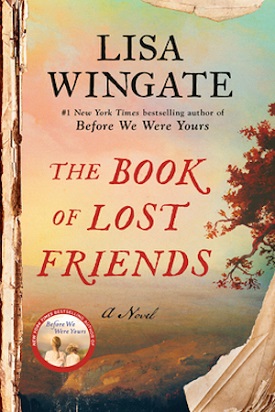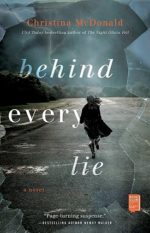 Synopsis:
Synopsis:
The Book of Lost Friends was inspired by historical events and is the story of three young women on a journey in search of family in the midst of the destruction of the post-Civil War South. It’s also the story of a teacher who discovers their story and its vital connection to her own students’ lives.
“Lost Friends” advertisements that appeared in Southern newspapers after the Civil War. They were desperate pleas from freed slaves for any information about their loved ones who had been sold off.
Louisiana, 1875: In the tumultuous aftermath of Reconstruction, three young women — unwilling companions — set off on a perilous quest. Lavinia, the pampered heir to a now-destitute plantation; Juneau Jane, her illegitimate free-born Creole half-sister; and Hannie, Lavinia’s former slave each carry private wounds and powerful secrets. They head for Texas, following dangerous roads rife with ruthless vigilantes and soldiers still fighting a war lost a decade before. For Lavinia and Juneau Jane, the journey is about inheritance and financial desperation. But for Hannie, torn from her mother and eight siblings before slavery ended, the pilgrimage westward reignites an agonizing question: Could her long-lost family members still be out there? Beyond the swamps lie the seemingly limitless frontiers of Texas and, improbably, perhaps, Hannie’s hopes.
Louisiana, 1987: For first-year teacher Benedetta “Benny” Silva, a subsidized job at a poor rural school seems like the ticket to canceling her hefty student debt — until she lands in a tiny, out-of-step Mississippi River town. The residents of Augustine, Louisiana are suspicious of new ideas and new people. Benny can scarcely comprehend the lives of her poverty-stricken students. But amid the gnarled live oaks and run-down plantation homes lies the century-old history of three young women, their long-ago journey, and a hidden book that could change everything . . .
Review:

The story opens in 1875 with Hannie, an eighteen-year-old former slave, still residing on the Louisiana plantation, Goswood Grove, where she was held against her will. She and her fellow former slaves are close to completing the ten-year sharecropper contract with “Old Mister” Gossett and then the little plot of land they have farmed will be theirs. Growing up, Hannie watched over Missy Lavinia, Old Mister’s spoiled, petulant daughter, while trying to stay away from her cruel mother.
Nights are especially hard for Hannie because when she closes her eyes she sees her mother, hears her voice, and relives being ripped away from her. Hannie and her family were stolen by Jeptha Loach, a nephew of Missus Gossett, en route to Texas where the Gossetts planned to establish a new plantation during the war. Loach sold off Hannie’s siblings, cousins, aunts, and mother to different buyers along the way. Hannie insisted to everyone she encountered that she had been stolen and was eventually returned to the Gossetts. All Hannie has left of her beloved family members are three blue beads that she wears around her neck — remnants of her grandmother’s necklace from Africa that was divided and distributed to every family member. Three beads each to wear as a sign of their identity should they ever be lucky enough to see each other again. “Blue means all us walk in the true way,” her grandmother said while sharing stories about Africa where their ancestors were queens and princes, and the origin of the invaluable beads.
It was real. We were real. A family together. ~~ Hannie
One night Hannie is surprised to see a visitor arrive at the plantation. Juneau Jane is the fourteen-year-old daughter of Old Mister and his placage wife in New Orleans. In those days, it was not uncommon for plantation owners to have more than one family, maintaining a separate home for a mistress of African, Native American, or mixed-race descent and the children. Old Mister has been away for four months, ever since he received word that his son, Lyle, was in trouble again, this time in Texas. The arrival of Juneau Jane indicates that Old Mister may be in trouble himself — or worse — and his absence means Old Missus may not honor the share cropper contract. Hannie sneaks into the main house to get information about Juneau Jane’s sudden appearance, and attempt to locate the contract so that it can’t be destroyed by Old Missus or anyone else. That sets in motion an epic and dangerous journey that has dramatic and permanent repercussions for Hannie, Lavinia, and Juneau Jane.
In 1987, Benny Silva arrives in the little town of Augustine to commence her career as a high school English teacher. She loves books and words, and wants to instill a love of reading in her students. She longs for them to “see that there is no faster way to change your circumstance than to open a great book.” But she finds there are no resources available to her except a few worn copies of Animal Farm and her students are not engaged. Many of them arrive at school hungry and she spends part of her modest income buying snacks to give them so that they can attempt to focus for a little while. Unlike the privileged students who attend the town’s other high school, many of her students have unstable home lives, including absent or inattentive parents and younger siblings they must care for. Benny wants to help her students rise above their circumstances and believes she may have found a way when LaJuna Carter reveals the huge collection of books in the house at Goswood Grove, “an amalgamation of the generations of residents” of the home. The house is owned by Nathan Gossett, following the death of his sister, Robin, two years earlier. She was in the midst of a mysterious project. Nathan wants nothing to do with the house, choosing to spend his time operating a shrimp boat on the coast, while his uncles operate the companies that employ most of the town’s residents. He has spent years trying to escape from his family’s history and tragedies. “it’s a horrible thing to realize that your family bought and sold people,” he observes. Benny seeks Nathan out and gets his permission to begin cataloguing the collection, hoping she will amass enough books to set up a classroom library. Benny also gets acquainted with Granny T, the plainspoken operator of the local diner, the Cluck and Oink barbecue. She becomes so enamored with Granny T and her wisdom that she invites her to come speak to her students. Granny T tells a mesmerizing story about her ancestors and how the local Carnegie Library was established — in costume. The students are inspired and excited to undertake a project — they will research local history and present, in costume as a local historical figure, their findings. Granny T says its a “[s]ad thing when stories die for the lack of listenin’ ears” and Benny posits that real stories might “teach the same lessons I was hoping to bring out in literature. What if I could make them part of my curriculum, somehow? Maybe they could help me understand this place and mu students. Maybe they could hep my students understand each other.” But some of the residents prefer that local history stay buried.
Wingate has been heralded a “master storyteller” for good reason. She employs alternating first-person narratives from Hannie and Benny set one hundred and twelve years apart. Interspersed are actual Lost Friend ads that were published in the Southwestern Christian Advocate, each of which is a heartbreaking story of a family ripped apart by slavery, war, and the aftermath of both. Both narratives are fast-paced and thoroughly engaging. As Hannie, Lavinia, and Juneau Jane, disguised as boys, travel deep into Texas in search of answers, they survive numerous close calls and encounter some surprising allies. Hannie experiences an awakening when they happen upon the Lost Friends ads. Because she can’t read, Juneau Jane must read them aloud to her and they create a book in which they keep the information. Word spreads about the book, and they add entries as former slaves beseech them to note details about their lost family members. Hannie dares to hope that she might find her beloved mama and other relatives because “[t]he greatest hardship to the heart is to endlessly wonder about your people.”
It is clear that the two storylines are related since Benny lives in a rented house on Gossett land which has passed through generations to Nathan. Wingate cleverly weaves a cohesive tale that is vividly and richly evocative, allowing her readers to effortlessly alternate their focus on the two time periods. She has taken care to remain faithful to the dialects of the regions and employed terminology relevant to the particular era. As a result, her characters’ voices are distinctive, authentic, and credible. Inclusion of the Lost Friends ads — “stories of actual people who lived, and struggled, and who almost inadvertently left these small pieces of themselves for posterity” — provides emotional power to the narratives, serving as an ever-present reminder that, although Hannie, Bennie, et al. are fictional characters, their stories are based on historical occurrences.
The Book of Lost Friends is a beautiful story told beautifully, inhabited by characters whose experiences evoke strong emotions and readers will remember long after reading the last page. Not surprisingly, the book debuted on the New York Times bestseller list immediately after publication and is destined to join Before We Were Yours as a classic and beloved volume of articulately-crafted historical fiction that resonates with and moves readers.
Excerpt from The Book of Lost Friends
Prologue
A single ladybug lands featherlight on the teacher’s finger, clings there, a living gemstone. A ruby with polka dots and legs. Before a slight breeze beckons the visitor away, an old children’s rhyme sifts through the teacher’s mind.
Ladybug, ladybug, fly away home,
Your house is on fire, and your children are gone.
The words leave a murky shadow as the teacher touches a student’s shoulder, feels the damp warmth beneath the girl’s roughly woven calico dress. The hand-stitched neckline hangs askew over smooth amber-brown skin, the garment a little too large for the girl inside it. A single puffy scar protrudes from one loosely buttoned cuff. The teacher wonders briefly about its cause, resists allowing her mind to speculate.
What would be the point? she thinks.
We all have scars.
She glances around the makeshift gathering place under the trees, the rough slabwood benches crowded with girls on the verge of womanhood, boys seeking to step into the world of men. Leaning over crooked tables littered with nib pens, blotters, and inkwells, they read their papers, mouthing the words, intent upon the important task ahead.
All except this one girl.
“Fully prepared?” the teacher inquires, her head angling toward the girl’s work. “You’ve practiced reading it aloud?”
“I can’t do it.” The girl sags, defeated in her own mind. “Not . . . not with these people looking on.” Her young face casts miserably toward the onlookers who have gathered at the fringes of the open-air classroom—moneyed men in well-fitting suits and women in expensive dresses, petulantly waving off the afternoon heat with printed handbills and paper fans left over from the morning’s fiery political speeches.
“You never know what you can do until you try,” the teacher advises. Oh, how familiar that girlish insecurity is. Not so many years ago, the teacher was this girl. Uncertain of herself, overcome with fear. Paralyzed, really.
“I can’t,” the girl moans, clutching her stomach.
Bundling cumbersome skirts and petticoats to keep them from the dust, the teacher lowers herself to catch the girl’s gaze. “Where will they hear the story if not from you—the story of being stolen away from family? Of writing an advertisement seeking any word of loved ones, and hoping to save up the fifty cents to have it printed in the Southwestern paper, so that it might travel through all the nearby states and territories? How will they understand the desperate need to finally know, Are my people out there, somewhere?”
The girl’s thin shoulders lift, then wilt. “These folks ain’t here because they care what I’ve got to say. It won’t change anything.”
“Perhaps it will. The most important endeavors require a risk.” The teacher understands this all too well. Someday, she, too, must strike off on a similar journey, one that involves a risk.
Today, however, is for her students and for the “Lost Friends” column of the Southwestern Christian Advocate newspaper, and for all it represents. “At the very least, we must tell our stories, mustn’t we? Speak the names? You know, there is an old proverb that says, ‘We die once when the last breath leaves our bodies. We die a second time when the last person speaks our name.’ The first death is beyond our control, but the second one we can strive to prevent.”
“If you say so,” the girl acquiesces, tenuously drawing a breath. “But I best do it right off, so I don’t lose my nerve. Can I go on and give my reading before the rest?”
The teacher nods. “If you start, I’m certain the others will know to follow.” Stepping back, she surveys the remainder of her group. All the stories here, she thinks. People separated by impossible distance, by human fallacy, by cruelty. Enduring the terrible torture of not knowing.
And though she’d rather not—she’d give anything if not—she imagines her own scar. One hidden beneath the skin where no one else can see it. She thinks of her own lost love, out there. Somewhere. Who knows where?
A murmur of thinly veiled impatience stirs among the audience as the girl rises and proceeds along the aisle between the benches, her posture stiffening to a strangely regal bearing. The frenzied motion of paper fans ceases and fluttering handbills go silent when she turns to speak her piece, looking neither left nor right.
“I . . .” her voice falters. Rimming the crowd with her gaze, she clenches and unclenches her fingers, clutching thick folds of the blue-and-white calico dress. Time seems to hover then, like the ladybug deciding whether it will land or fly on.
Finally, the girl’s chin rises with stalwart determination. Her voice carries past the students to the audience, demanding attention as she speaks a name that will not be silenced on this day. “I am Hannie Gossett.”
Chapter 1
Hannie Gossett — Louisiana, 1875
The dream takes me from quiet sleep, same way it’s done many a time, sweeps me up like dust. Away I float, a dozen years to the past, and sift from a body that’s almost a woman’s into a littlegirl shape only six years old.
Though I don’t want to, I see what my little-girl eyes saw then.
I see buyers gather in the trader’s yard as I peek through the gaps in the stockade log fence. I stand in winter-cold dirt tramped by so many feet before my own two. Big feet like Mama’s and small feet like mine and tiny feet like Mary Angel’s. Heels and toes that’s left dents in the wet ground.
How many others been here before me? I wonder. How many with hearts rattlin’ and muscles knotted up, but with no place to run?
Might be a hundred hundreds. Heels by the doubles and toes by the tens. Can’t count high as that. I just turned from five years old to six a few months back. It’s Feb’ary right now, a word I can’t say right, ever. My mouth twists up and makes Feb-ba-ba-ba-bary, like a sheep. My brothers and sisters’ve always pestered me hard over it, all eight, even the ones that’s younger. Usually, we’d tussle if Mama was off at work with the field gangs or gone to the spinnin’ house, cording wool and weaving the homespun.
Our slabwood cabin would rock and rattle till finally somebody fell out the door or the window and went to howlin’. That’d bring Ol’ Tati, cane switch ready, and her saying, “Gonna give you a breshin’ with this switch if you don’t shesh now.” She’d swat butts and legs, just play-like, and we’d scamper one over top the other like baby goats scooting through the gate. We’d crawl up under them beds and try to hide, knees and elbows poking everywhere.
Can’t do that no more. All my mama’s children been carried off one by one and two by two. Aunt Jenny Angel and three of her four girls, gone, too. Sold away in trader yards like this one, from south Louisiana almost to Texas. My mind works hard to keep account of where all we been, our numbers dwindling by the day, as we tramp behind Jep Loach’s wagon, slave chains pulling the grown folk by the wrist, and us children left with no other choice but to follow on.
But the nights been worst of all. We just hope Jep Loach falls to sleep quick from whiskey and the day’s travel. It’s when he don’t that the bad things happen—to Mama and Aunt Jenny both, and now just to Mama, with Aunt Jenny sold off. Only Mama and me left now. Us two and Aunt Jenny’s baby girl, li’l Mary Angel.
Every chance there is, Mama says them words in my ear—who’s been carried away from us, and what’s the names of the buyers that took them from the auction block and where’re they gone to. We start with Aunt Jenny, her three oldest girls. Then come my brothers and sisters, oldest to youngest, Hardy at Big Creek, to a man name LeBas from Woodville. Het at Jatt carried off by a man name Palmer from Big Woods. . . .
Prat, Epheme, Addie, Easter, Ike, and Baby Rose, tore from my mama’s arms in a place called Bethany. Baby Rose wailed and Mama fought and begged and said, “We gotta be kept as one. The baby ain’t weaned! Baby ain’t . . .”
It shames me now, but I clung on Mama’s skirts and cried, “Mama, no! Mama, no! Don’t!” My body shook and my mind ran wild circles. I was afraid they’d take my mama, too, and it’d be just me and little cousin Mary Angel left when the wagon rolled on.
Excerpted from The Book of Lost Friends by Lisa Wingate. Copyright © 2020 by Lisa Wingate. Excerpted by permission of Random House Publishing Group – Ballantine. All rights reserved.



1 Comment
I enjoy reading books about topics I’m not really familiar and trafficking is something I really don’t know much about. I also enjoy books with strong female characters and Alice Vega definitely sounds like a strong women. Definitely adding this one to my list.